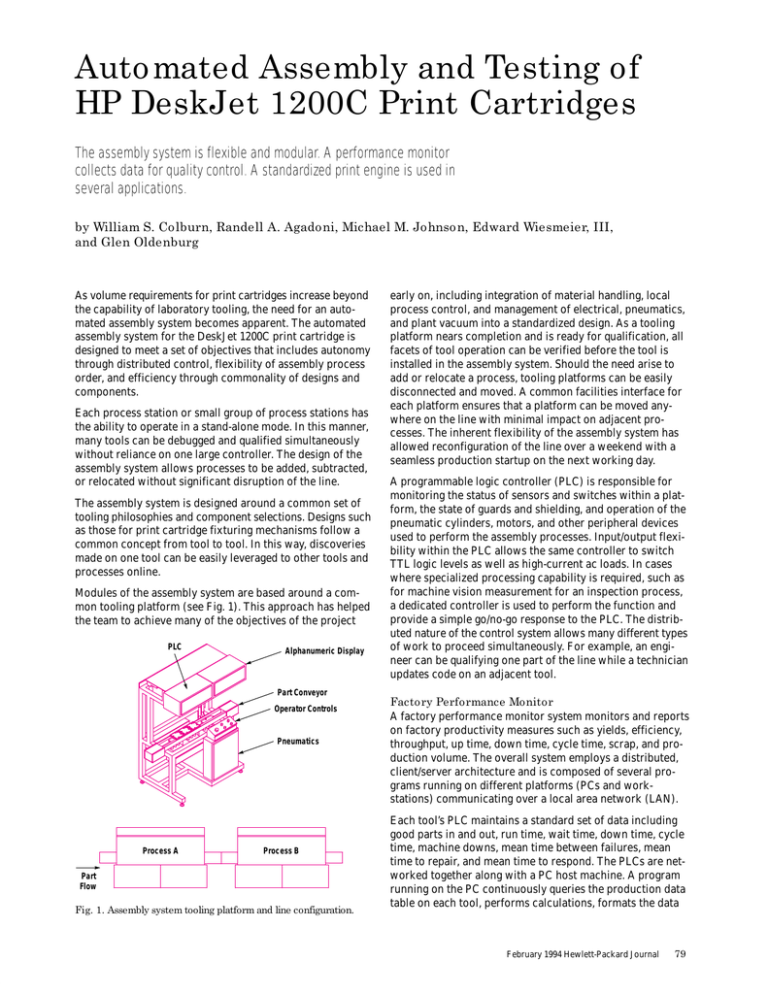Automated Assembly and Testing of HP DeskJet 1200C Print Cartridges
advertisement

Automated Assembly and Testing of HP DeskJet 1200C Print Cartridges The assembly system is flexible and modular. A performance monitor collects data for quality control. A standardized print engine is used in several applications. by William S. Colburn, Randell A. Agadoni, Michael M. Johnson, Edward Wiesmeier, III, and Glen Oldenburg As volume requirements for print cartridges increase beyond the capability of laboratory tooling, the need for an automated assembly system becomes apparent. The automated assembly system for the DeskJet 1200C print cartridge is designed to meet a set of objectives that includes autonomy through distributed control, flexibility of assembly process order, and efficiency through commonality of designs and components. Each process station or small group of process stations has the ability to operate in a stand-alone mode. In this manner, many tools can be debugged and qualified simultaneously without reliance on one large controller. The design of the assembly system allows processes to be added, subtracted, or relocated without significant disruption of the line. The assembly system is designed around a common set of tooling philosophies and component selections. Designs such as those for print cartridge fixturing mechanisms follow a common concept from tool to tool. In this way, discoveries made on one tool can be easily leveraged to other tools and processes online. Modules of the assembly system are based around a common tooling platform (see Fig. 1). This approach has helped the team to achieve many of the objectives of the project PLC Alphanumeric Display early on, including integration of material handling, local process control, and management of electrical, pneumatics, and plant vacuum into a standardized design. As a tooling platform nears completion and is ready for qualification, all facets of tool operation can be verified before the tool is installed in the assembly system. Should the need arise to add or relocate a process, tooling platforms can be easily disconnected and moved. A common facilities interface for each platform ensures that a platform can be moved anywhere on the line with minimal impact on adjacent processes. The inherent flexibility of the assembly system has allowed reconfiguration of the line over a weekend with a seamless production startup on the next working day. A programmable logic controller (PLC) is responsible for monitoring the status of sensors and switches within a platform, the state of guards and shielding, and operation of the pneumatic cylinders, motors, and other peripheral devices used to perform the assembly processes. Input/output flexibility within the PLC allows the same controller to switch TTL logic levels as well as high-current ac loads. In cases where specialized processing capability is required, such as for machine vision measurement for an inspection process, a dedicated controller is used to perform the function and provide a simple go/no-go response to the PLC. The distributed nature of the control system allows many different types of work to proceed simultaneously. For example, an engineer can be qualifying one part of the line while a technician updates code on an adjacent tool. Part Conveyor Operator Controls Pneumatics Process A Process B Part Flow Fig. 1. Assembly system tooling platform and line configuration. Factory Performance Monitor A factory performance monitor system monitors and reports on factory productivity measures such as yields, efficiency, throughput, up time, down time, cycle time, scrap, and production volume. The overall system employs a distributed, client/server architecture and is composed of several programs running on different platforms (PCs and workstations) communicating over a local area network (LAN). Each tool’s PLC maintains a standard set of data including good parts in and out, run time, wait time, down time, cycle time, machine downs, mean time between failures, mean time to repair, and mean time to respond. The PLCs are networked together along with a PC host machine. A program running on the PC continuously queries the production data table on each tool, performs calculations, formats the data February 1994 Hewlett-Packard Journal 79 and sends it as a package to a server program running on a separate workstation. The server program receives the data package and makes it available to client programs via the site LAN. The client program for end users comes in two windowsbased flavors: a Microsoft Windows version for desktop PC users and an OSF/Motif version for workstations or X terminals on the factory floor. After connecting to the server, clients receive data packages and update a graphical view of the factory, using buttons that change color to represent each tool and its current status (running, down, or waiting for parts to process). When a tool button is pressed using a mouse pointer, a window pops up to display a real time summary of that tool’s performance. A top-level menu is used to select options such as module or overall line performance, to set alarms, or to review production summaries of previous shifts. Additional client programs are used to pull periodic summaries of production data for reporting and database archiving. The information from this system has proven to be indispensable in managing the factory, identifying areas for improvement, and planning. Quality Control Two primary design goals for the factory affect the strategy for process quality control: • Emphasize inline, early detection and correction of process quality problems (as opposed to end-of-line audit tests) • Design for and maintain local control of all process tools, doing as much quality control at the local tool as possible (as opposed to off-tool quality control). The emphasis is on real-time, local process control and alerting rather than on data archival and off-tool testing. Therefore, process control for a particular tool is first accommodated within the tool. Off-tool statistical quality control is used only where direct process control and real-time alerting do not suffice. A comprehensive quality control plan was first developed that described the key process performance measures for each process along with the appropriate level or method of quality control to monitor the process performance measures. The quality control methods range from simple go/ no-go checks to online, real-time statistical quality control. System tools were developed to monitor process parameters using industry-standard statistical quality control techniques. The statistical quality control system uses a graphical user interface (OSF/Motif) and is designed to be a generic, project independent tool that is configurable for any statistical quality control test. The statistical quality control system has two operating modes: • Offline sample test bed. Print cartridge samples are tested offline periodically using various test controllers that communicate with the statistical quality control system over a serial port. • Real-time statistical quality control. The system monitors the output data files of any process, performing real-time analysis. X terminals are located near the tool, providing immediate feedback to operators about the health of the process. 80 February 1994 Hewlett-Packard Journal In both modes, the statistical quality control system’s graphical outputs indicate when a process is out of control or if a print cartridge parameter is out of specification, and it is the responsibility of the operators or technicians to take appropriate action. Engineers are responsible for setting control limits, sampling frequencies, and action plans for each statistical quality control test. Automated Quality Tester Following final assembly, the quality of each DeskJet 1200C print cartridge is evaluated. All print cartridges are tested by an automated test tool. The tester is based on the original tester design for the DeskJet print cartridge and represents an ongoing evolution in print cartridge tester design.1-3 The objective of the tester is to exercise the print cartridge and measure its attributes with respect to print cartridge specifications. The two tests used to measure print cartridge quality are a machine vision analysis of printed images and the measurement of print cartridge electrical parameters. The tester can be divided into four functional areas: print mechanism, vision analysis engine, electrical tester, and system controller. The print mechanism moves media beneath the print cartridge while the test pattern is being printed. Tensioning, supply, and takeup are also managed by this mechanism. Once printed, test patterns are analyzed by the vision engine. CCD cameras supply images to the vision engine where they are processed and evaluated. Finally, the electrical tester verifies the print cartridge’s electrical integrity. The results from both the vision engine and the electrical tester are sent to the system controller where they are collated and forwarded to the central line controller. The machine readable print sample (Fig. 2) is composed of two primary patterns. One pattern is used to detect the print mode failures of banding and horizontal trajectory. The other pattern provides a means of analyzing individual nozzles for dot size and vertical trajectory. Dot size provides a rough estimate of a more significant parameter, drop volume. In addition, the fragile nature of the die and TAB beam attachments require electrical testing following print cartridge assembly. The interconnects are probed for open and short circuit conditions and for parametric measurements of special die features. Print quality results depend heavily on the characteristics of the medium on which the patterns are printed. Print sample positioning within the camera field of view can vary based on the elasticity of the medium, requiring periodic camera adjustment. Moreover, variations in ink bleed along the medium fibers can complicate the issues of vision analysis. The tester features several advancements beyond previous print cartridge tester designs. Hardware capabilities are extended to provide automated, closed-loop lighting level and color filtration adjustment. Programmable components are included to provide support for both the DeskJet 1200C and DesignJet 650C cartridges. Vision processing algorithms were developed that are insensitive to fluctuations in lighting and magnification levels, and that allow cycle-time improvements through the simple addition of off-the-shelf vision engines. Statistical tools were developed to analyze realtime system performance. With all programmable devices Banding Weak Nozzle Horizontal Trajectory Vertical Trajectory Fig. 2. In the print cartridge quality tester, a machine vision system scans the test pattern (center) printed by each cartridge to detect various defects. linked through a single workstation, it is possible to change individual components without preconfiguring them. A Print Engine for Multiple Needs New print cartridges are different from those for older product lines. Sometimes the differences are substantial. Every print cartridge design must be thoroughly tested well before its companion printer exists. A flexible tester print engine called SPOT+ makes this possible (SPOT+ is not an acronym or abbreviation). In the DeskJet 1200C print cartridge quality tester described above, and in other print cartridge testers, SPOT+ engages the cartridges and fires them. Fig. 3 is a block diagram of SPOT+. SPOT+ is very different from HP’s production model printers because it satisfies a different set of needs. Unlike any production printer, SPOT+ must work with many types of print cartridges. It must also be independent of printer mechanics. Finally, it must be flexible enough to be used in various kinds of test applications. SPOT+ uses print cartridge firing orders, print cartridge maps, programmable firing waveforms, and programmable print cartridge drive voltages to gain independence from print cartridge types. The firing order is a data structure that works with special hardware to control which nozzles are fired together and when they are fired relative to other nozzles. The firing order helps designers optimize the physical layout of each print cartridge for fluid dynamics and thermodynamics. The print cartridge map is a data structure that allows the firmware to shuffle print data around to match various wiring configurations. Wiring is influenced by print cartridge layout, flexible cable layout, and the layout of the driver card being used. February 1994 Hewlett-Packard Journal 81 Personal Computer High-Level Commands HP-IB Interface Print Cartridge CPU (68000) Image Advance Counter Image Memory (Optional) Image Data Fire Data Fire Order External Encoder or Internal Trigger Clock Control Fire Order Advance Counter Fire Order Memory Timing Generator Print Cartridge Drivers Firing Waveshape Strobe Output for Triggering External Devices Fig. 3. Block diagram of the SPOT+ print engine. All testers that use SPOT+ take advantage of the firing orders, print cartridge maps, programmable firing waveforms, and programmable print cartridge drive voltages. Most testers also use SPOT+’s ability to fire bursts. A burst is a firing of a selectable number of drops from one or more nozzles. Nozzles can be turned off by clearing their control bit in a mask data structure. The mask feature is important for the many different types of testers. These testers need to disable nozzles that have problems to prevent them from affecting the tests on the remaining good nozzles. Two types of testers that do not use burst firing are printer emulators and print quality testers. The printer emulator prints recognizable images much like any printer. Its advantage is that it allows a print cartridge to print images before the print cartridge’s companion printer product is designed. The print quality tester is a manufacturing tool that also prints images, as described above. SPOT+ includes measurement circuitry so that print cartridge parameters can be monitored. Nozzle resistor continuity, nozzle resistor resistance, drive voltage, and operating temperature can all be measured. For example, a resistance scan tester uses the resistance measuring feature to report the nozzle resistance nozzle by nozzle. This information is used to exclude bad nozzles from further testing. Measurements of resistor continuity and drop ejection serve similar purposes. Drop ejection (see below) is detected with additional hardware. SPOT+ supplies a hardware output called the strobe. It is used in experimental testers to inform other hardware that a particular nozzle has just fired a drop. In addition to the burst and image modes of firing, SPOT+ also offers an autoburst firing mode. The autoburst repeats a series of high-frequency bursts at a much lower repetition frequency. This permits testers to explore high-frequency 82 February 1994 Hewlett-Packard Journal print cartridge firing while allowing the print cartridge sufficient time to recover for the next burst of drops. The flexibility designed into SPOT+ results in considerable complexity, but it has paid off well in standardization of testers. Increased up time and ease of maintainability are two unforeseen benefits that have emerged. SPOT+ systems are now used throughout HP in sites as diverse as San Diego, Corvallis, HP Laboratories in Palo Alto, and Singapore. Drop Detection Many HP print cartridge testers need to verify that drops are being fired. This is done by means of an optoelectronic drop detector as outlined in Fig. 4. The bulb, the lens and the detector establish the optical path. To a first approximation, all the light that travels from the bulb and reaches the lens is collected at the detector. The test controller (not shown) causes a single nozzle of the print cartridge to eject drops, provided, of course, that the nozzle does in fact work. The ejected drop passes through the optical path, causing a reduction of the flux of light from the bulb to the detector. The output signal of the detector is fed to a data acquisition board of the test controller. The signal processing software in the test controller produces a simple yes/no indication with a small but specified probability of error. There are several requirements for the optical path. The sensitive area covered by the optical path must be large enough to cover the entire nozzle plate. Otherwise, a positioning mechanism would be necessary to align the sensitive area of the optical path with the nozzle to be tested. Since a typical tester contains many print cartridge test stations this would be a complex and expensive proposition. Signal of Drop #1 Print Cartridge Ink Drop Signal of Drop #2 Bulb Cylindrical Lens Detector Furthermore, the change of light flux must be rather independent of the trajectory of the passing drop. Otherwise, certain nozzles that produce unacceptable drops might be classified as functional while others that produce small but acceptable drops might be classified as nonfunctional. Finally, the optical path components should be simple, small in number, and easy to assemble. The design shown in Fig. 4 fulfills all these requirements. Fig. 5 shows an example of a computer simulation of the flux change or sensitivity as a function of the drop location (xo,yo). The left side is nearest the bulb and the right side is nearest the lens. The sensitivity varies significantly, but it is possible to select zones that are quite usable for our purposes. First, there is a rather flat zone next to the bulb and secondly, there are ridge lines of nearly constant sensitivity straddling the peak parallel to the optical axis (x axis). If the optical path is laid out properly, the flat part provides a large zone of somewhat low sensitivity. If the nozzles of the print cartridge happen to be arranged in two columns, one can lay out the optical path so that these columns coincide with two ridge lines of the same nearly constant sensitivity. In this case, one can achieve both constancy and a high value of the sensitivity . xo,yo) yo xo 0.4 inch 3.0 inches Fig. 5. Sensitivity of the drop detector as a function of drop position. Average Signal Fig. 4. Drop detector components. Signal of Drop #N Signal of Drop #3 Preamplifier 1 2 3 4 5 M Time Slice Fig. 6. Averaging of the drop detector output signals for several drops reduces noise and produces a signal that can be interpreted. Even with an optimized optical path, the detector output signal is rather noisy. The noise comes from jitter in the drop generation process, mechanical and electrical noise, extraneous light, 1/f noise of the detector, and other sources. Fig. 6 demonstrates the method used to minimize the influence of noise. Since the noise sources are almost entirely uncorrelated with each other and with the drop signal, the averaging of several signals reinforces the signal in proportion to the number of signals averaged, while the noise will grow only as the square root of that number. Therefore, the ratio of signal to noise improves as the square root of the number of signals averaged. Several metrics of the averaged signal can be employed to arrive at the desired decision. Level triggering, peak-to-peak value, and rms value have all been successfully used. February 1994 Hewlett-Packard Journal 83 Acknowledgments The idea of architecting the print cartridge assembly line around a common tooling platform was the result of the creative contributions of many people. The authors would like to thank Tim Carlin, Jim Sykora, Roy Pilcher, Carol Beamer, and Deb Hockley for their early efforts which helped to catalyze the tooling platform concept. The efforts of Mick Trego, Hanno Ix, and Dave Etherton made automated testing of the DeskJet 1200C print cartridges a reality. The individual process and manufacturing engineers are due a great deal of credit for tolerating the many surveys and meetings that provided us with the information needed to help make the automated assembly system a success. 84 February 1994 Hewlett-Packard Journal References 1. M.J. Monroe, “Machine Vision in Color Print Cartridge Production,” Hewlett-Packard Journal, Vol. 43, no. 4, August 1992, pp. 87-92. 2. M.C. Huth, et al, “CIM and Machine Vision in the Production of Thermal Inkjet Printheads,” Hewlett-Packard Journal, Vol. 39, no. 5, October 1988, pp. 91-98. 3. J.P. Baker, et al, “Design and Development of a Color Thermal Inkjet Print Cartridge,” Hewlett-Packard Journal, Vol. 39, no. 4, August 1988, pp. 6-15. Microsoft is a U.S. registered trademark of Microsoft Corporation.


